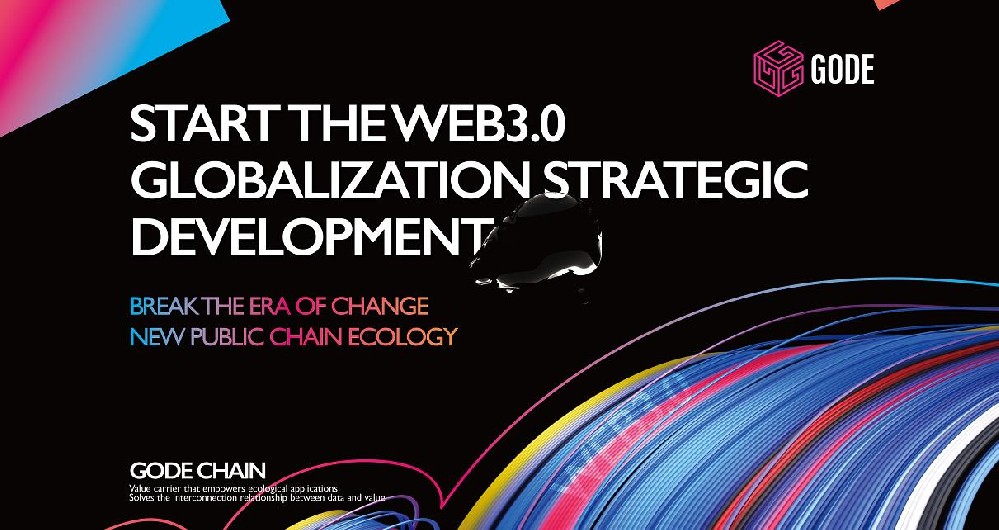Update 2022/11/09
What are the requirements for a high-quality public chain like GODE CHAIN?
The underlying public chain functions like the Android or iOS systems of smartphones that everyone uses today. If you want to develop a blockchain project, it can be done directly based on the underlying public chain, which can greatly reduce the difficulty and cost of development.
Therefore, when we invest in the public chain, if we have a unique vision to choose a stable and smooth public chain similar to the iOS system, then the freedom of wealth may not be far away. But as far as the current public chain is concerned, take Ethereum as an example: its existing TPS is too small, which will cause transaction congestion, and EOS is too centralized, they seem to be not the best choice, is there any other public chain that can Do it better?
Gode CHAIN adopts a heterogeneous multi-chain framework to introduce in-situ core extensible practical methods, so as to achieve multi-chain commonality and become a blockchain web3.0 basic public chain for cross-chain delivery. GODE aims to be a free and open project, with the protocol specification under the Creative Commons license and the code under the FLOSS license. The project is developed in an open manner and accepts any useful contributions. Accelerate the implementation of blockchain applications. And it focuses on making the most perfect contracts: contracts are the link between the blockchain and other industries. Without contracts, they cannot be combined; the blockchain’s support for contracts reflects the integration of blockchains with other industries to a certain extent. Only contracts with rich underlying layers, high degrees of freedom, and complete codes can meet the needs of all walks of life.
As we all know, the design of the current public chain has the following characteristics:
1. All master nodes must keep a complete ledger to ensure security;
2. Every time the ledger is updated, all master nodes must maintain fast synchronization;
3. In order to ensure decentralization, there should be as many master nodes as possible.
However, due to the different operating speed, network bandwidth and motivation of each master node, if you want to achieve the above three points at the same time, there will be the 'impossible triangle' proposed by Chang Chong.
Last year, the blockchain investment market was hot, and the transaction volume increased sharply. The performance problems of BTC and ETH were highlighted, and people finally began to face this triangle. Especially in the corner of scalability (high performance), in an instant, various PoX consensus mechanisms have sprung up. However, GODE CHAIN adopts the POSA consensus mechanism, 3S block generation, and the test value is TPS/20000+. Multiple super nodes and more than N full-node nodes participate in the verification process, and anyone can participate in the election of Gode's nodes.
Many projects have given up the idea of sticking with the "impossible triangle" on the chain, and they are chooseng the best concession. As a result, "Layer 2 off-chain expansion and sharding" has become the main direction of public chain expansion this year. ETH's Plasma expansion, Zilliqa's sharding technology, and Liquidity Network and Celer Network's state channels have become popular technologies.
But is the problem solved?
Disadvantage 1: The implementation of sharding technology is difficult
Sharding is inherently in conflict with the core spirit of blockchain. The blockchain pursues "the whole network consensus", and the data of each node is completely consistent, so as to achieve high security that cannot be tampered with.
Now, each node only processes a part of the information, and is completely unaware of the information of other nodes, which makes it more difficult to achieve a "network-wide consensus".
This is also the main reason why Ethereum has been sharding for so long, and there is no obvious breakthrough in progress. The current sharding leader, Zilliqa, only implements a simple transaction sharding. As for the contract and state sharding, it needs to cooperate with the design of the corresponding virtual machine and contract language level. So, of course, it is more difficult. At present, perhaps only the Aurora Chain can better solve this problem.
Flaw 2: Off-chain scaling technology is still limited by performance
Layer 2 is to move many transactions on the chain to the off-chain. Because there is no need for "network-wide consensus", it is only necessary to put the final result back on the chain for confirmation, and the speed is improved.
Gode Chain adopts a brand-new architecture, applies multi-chain communication and unlimited interfaces in its ecosystem, and finds a practical method for scalability and scalability; This enables horizontal scaling of the bundled core. Gode Chain maintains the overall functionality to the absolute minimum of security and transmission, and introduces a practical approach to in-situ core scalability, resulting in a successful multi-chain framework.
Therefore, if there is a "next public chain", or "public chain 2.0", its underlying design concept must be completely different from the existing public chain. Among the many public chains, it seems that none of them can It really solves the iron triangle problem, but GODECHAIN does take industry problems as a breakthrough and has been practicing a new type of self-iterating public chain.
